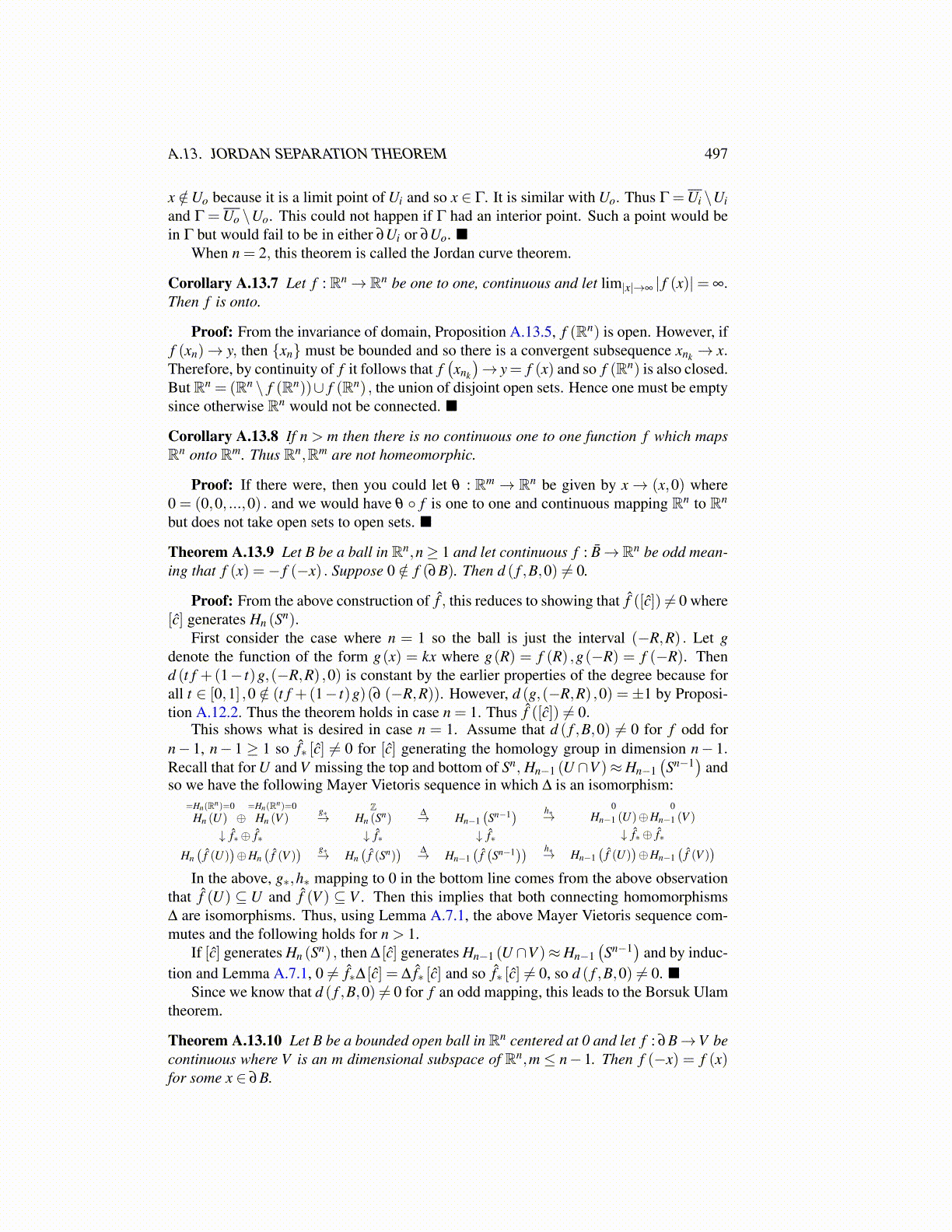
A.13. JORDAN SEPARATION THEOREM 497
x /∈Uo because it is a limit point of Ui and so x ∈ Γ. It is similar with Uo. Thus Γ =Ui \Uiand Γ = Uo \Uo. This could not happen if Γ had an interior point. Such a point would bein Γ but would fail to be in either ∂Ui or ∂Uo. ■
When n = 2, this theorem is called the Jordan curve theorem.
Corollary A.13.7 Let f : Rn→ Rn be one to one, continuous and let lim|x|→∞ | f (x)|= ∞.Then f is onto.
Proof: From the invariance of domain, Proposition A.13.5, f (Rn) is open. However, iff (xn)→ y, then {xn} must be bounded and so there is a convergent subsequence xnk → x.Therefore, by continuity of f it follows that f
(xnk
)→ y= f (x) and so f (Rn) is also closed.
But Rn = (Rn \ f (Rn))∪ f (Rn) , the union of disjoint open sets. Hence one must be emptysince otherwise Rn would not be connected. ■
Corollary A.13.8 If n > m then there is no continuous one to one function f which mapsRn onto Rm. Thus Rn,Rm are not homeomorphic.
Proof: If there were, then you could let θ : Rm → Rn be given by x→ (x,0) where0 = (0,0, ...,0) . and we would have θ ◦ f is one to one and continuous mapping Rn to Rn
but does not take open sets to open sets. ■
Theorem A.13.9 Let B be a ball in Rn,n≥ 1 and let continuous f : B̄→Rn be odd mean-ing that f (x) =− f (−x) . Suppose 0 /∈ f (∂B). Then d ( f ,B,0) ̸= 0.
Proof: From the above construction of f̂ , this reduces to showing that f̂ ([ĉ]) ̸= 0 where[ĉ] generates Hn (Sn).
First consider the case where n = 1 so the ball is just the interval (−R,R) . Let gdenote the function of the form g(x) = kx where g(R) = f (R) ,g(−R) = f (−R). Thend (t f +(1− t)g,(−R,R) ,0) is constant by the earlier properties of the degree because forall t ∈ [0,1] ,0 /∈ (t f +(1− t)g)(∂ (−R,R)). However, d (g,(−R,R) ,0) =±1 by Proposi-tion A.12.2. Thus the theorem holds in case n = 1. Thus f̂ ([ĉ]) ̸= 0.
This shows what is desired in case n = 1. Assume that d ( f ,B,0) ̸= 0 for f odd forn− 1, n− 1 ≥ 1 so f̂∗ [ĉ] ̸= 0 for [ĉ] generating the homology group in dimension n− 1.Recall that for U and V missing the top and bottom of Sn, Hn−1 (U ∩V )≈Hn−1
(Sn−1
)and
so we have the following Mayer Vietoris sequence in which ∆ is an isomorphism:=Hn(Rn)=0
Hn (U) ⊕=Hn(Rn)=0
Hn (V )g∗→
ZHn (Sn)
∆→ Hn−1(Sn−1)
↓ f̂∗⊕ f̂∗ ↓ f̂∗ ↓ f̂∗Hn(
f̂ (U))⊕Hn
(f̂ (V )
) g∗→ Hn(
f̂ (Sn)) ∆→ Hn−1
(f̂(Sn−1))
h∗→0
Hn−1 (U)⊕0
Hn−1 (V )
↓ f̂∗⊕ f̂∗h∗→ Hn−1
(f̂ (U)
)⊕Hn−1
(f̂ (V )
)In the above, g∗,h∗ mapping to 0 in the bottom line comes from the above observation
that f̂ (U) ⊆ U and f̂ (V ) ⊆ V . Then this implies that both connecting homomorphisms∆ are isomorphisms. Thus, using Lemma A.7.1, the above Mayer Vietoris sequence com-mutes and the following holds for n > 1.
If [ĉ] generates Hn (Sn) , then ∆ [ĉ] generates Hn−1 (U ∩V )≈Hn−1(Sn−1
)and by induc-
tion and Lemma A.7.1, 0 ̸= f̂∗∆ [ĉ] = ∆ f̂∗ [ĉ] and so f̂∗ [ĉ] ̸= 0, so d ( f ,B,0) ̸= 0. ■Since we know that d ( f ,B,0) ̸= 0 for f an odd mapping, this leads to the Borsuk Ulam
theorem.
Theorem A.13.10 Let B be a bounded open ball in Rn centered at 0 and let f : ∂B→V becontinuous where V is an m dimensional subspace of Rn,m ≤ n− 1. Then f (−x) = f (x)for some x ∈ ∂B.